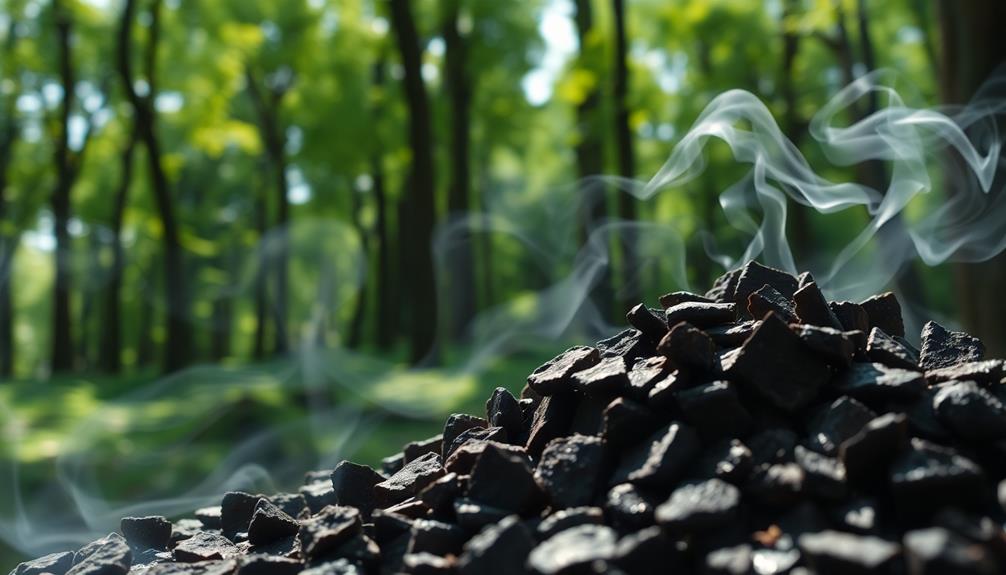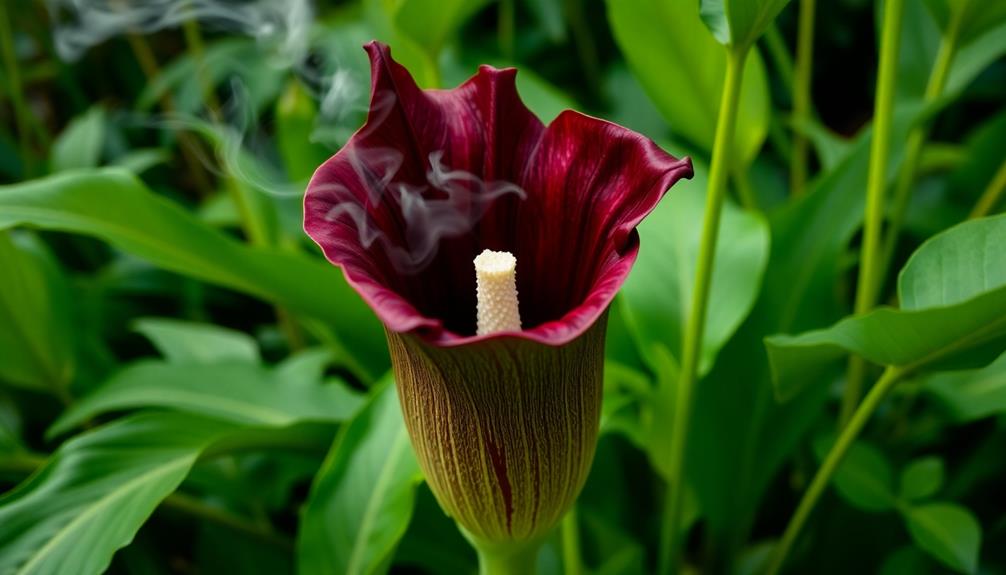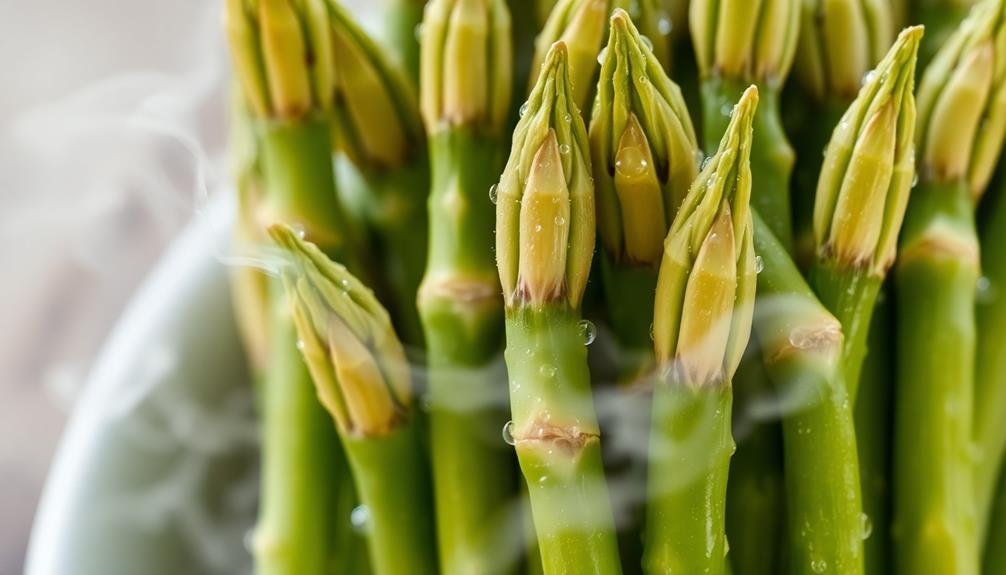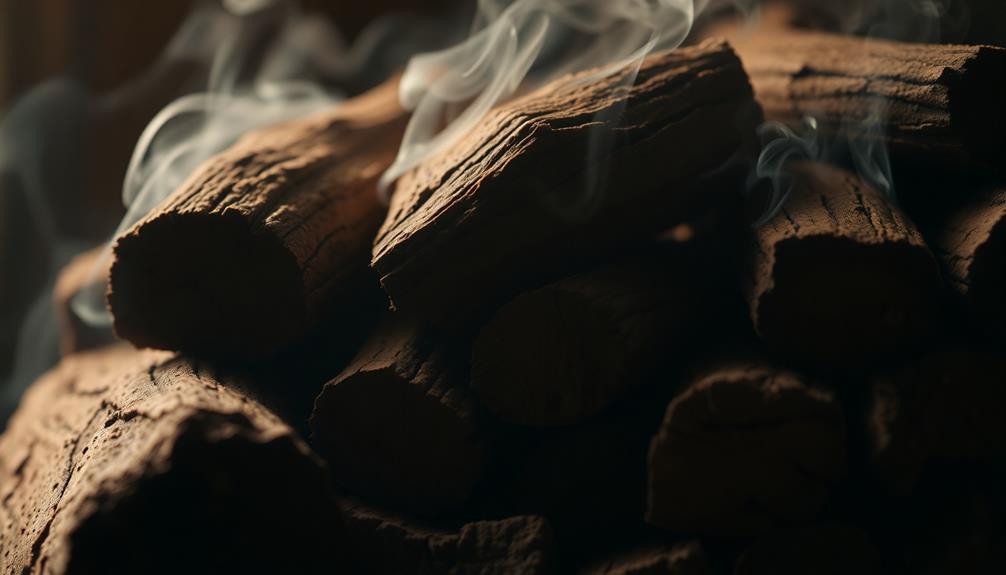Agarwood, often called "liquid gold," has a scent that's truly unique! You'll notice deep, rich aromas that mix earthy and sweet notes with warm, woody undertones. It's got hints of spice and smokiness, plus maybe a touch of floral sweetness to balance everything out. People love using agarwood in perfumes and incense, especially in peaceful spaces like yoga studios or during meditation. It's not just about smelling good; it also has cultural significance. So, if you're curious about how to experience this magical scent in your own life, there's much more to discover!
Key Takeaways
- Agarwood has a deep, rich, and complex scent that combines earthy and sweet notes with warm, woody undertones.
- The aroma features hints of spice and smokiness, creating a unique and captivating fragrance.
- Some variations of agarwood may have slight floral notes that balance the overall richness of the scent.
- It is often associated with relaxation and meditation, enhancing spiritual and tranquil environments.
- The scent can vary significantly based on the sourcing and processing methods used for the agarwood.
Introduction

Agarwood, often referred to as "liquid gold," is renowned for its distinctive and captivating scent. You might be wondering why it's so special. Well, agarwood comes from a tree called Aquilaria, which produces a dark, fragrant resin when it's infected by a specific mold. This resin is what gives agarwood its incredible aroma, and that's why people treasure it.
Imagine walking through a forest filled with amazing scents; that's what agarwood can bring to your space. This aromatic wood isn't just for show; it's been used for centuries in perfumes, incense, and even traditional medicine. You might come across it in various forms, like essential oils or small chips that you can burn.
It's fascinating how a simple piece of wood can create such rich experiences, isn't it? Plus, the history behind agarwood adds to its allure. Different cultures have their own unique ways of using it, showcasing its versatility.
Description of the Smell
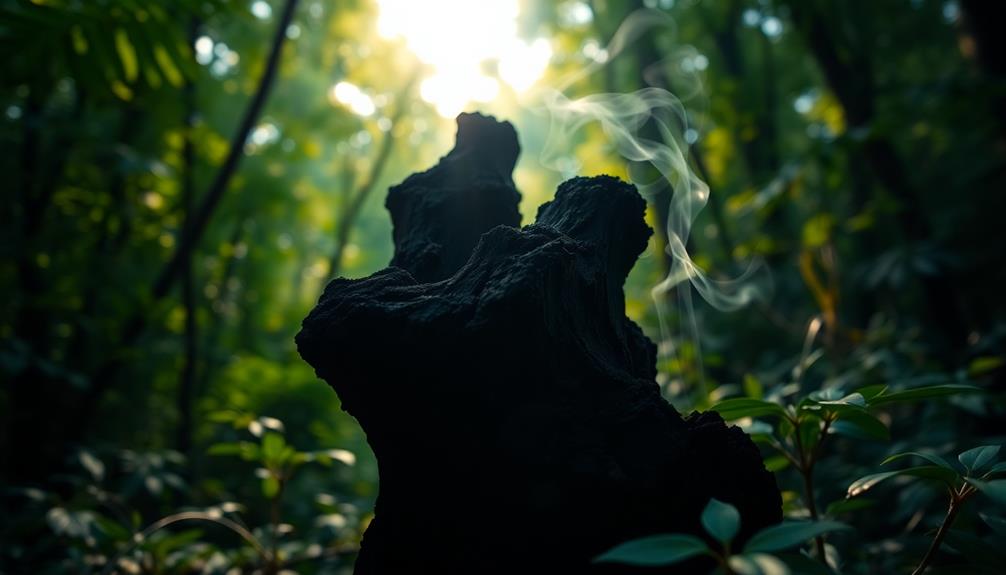
The scent of agarwood is often described as deep, rich, and complex, with a harmonious blend of earthy and sweet notes. When you take a whiff, you might notice warm, woody undertones that remind you of a cozy cabin in the woods. It's not just any wood, though; agarwood has a unique twist that makes it stand out. You could say it smells like nature's best-kept secret.
As you breathe in, you might detect hints of spice and a touch of smokiness, which adds to its allure. It's like going on an adventure through a fragrant forest, where every corner reveals something new. Some people even say it has a slightly floral note, which balances the richness beautifully.
When you think of agarwood, imagine a comforting embrace that wraps around you, inviting you to relax and enjoy the moment.
It's no wonder that many cultures cherish this scent for meditation and relaxation. So, if you've never experienced agarwood, you're in for a treat. Just remember, it's not your everyday smell—it's something extraordinary that might just make you smile!
Source and Composition
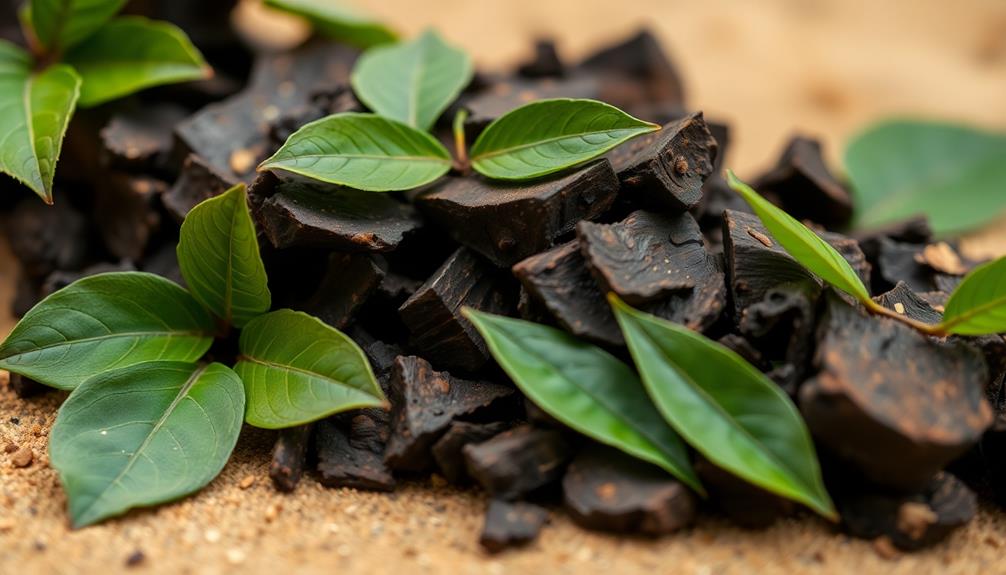
Known for its captivating aroma, agarwood originates from the Aquilaria tree, primarily found in Southeast Asia. This unique tree produces a dark, fragrant resin when it becomes infected with a specific type of mold. It's like nature's way of protecting itself! The resin, known as oud, is what gives agarwood its distinctive scent.
Agarwood isn't just any old tree; it requires a special combination of factors to thrive. It loves humid climates, so you'll primarily find it in tropical forests. The resinous heartwood forms over many years, which is why agarwood can be quite valuable. You could say it's a treasure of nature!
The composition of agarwood is fascinating too. It contains various aromatic compounds, including sesquiterpenes and chromones, which contribute to its rich and complex fragrance.
Each piece of agarwood is different, meaning the smell can vary from sweet and woody to spicy and earthy, depending on where it's sourced and how it's processed. So, if you ever get a chance to experience agarwood, you're in for a real olfactory treat! Just remember, not all of it's the same, and that's what makes it so special.
Typical Scenarios or Environments

Imagine stepping into a serene temple or a tranquil spa; you're likely to encounter the enchanting scent of agarwood. This unique aroma often fills spaces where relaxation and mindfulness are key.
Picture a yoga studio, where the soothing scent creates a peaceful atmosphere, helping you focus on your breath and movements. In these environments, the rich, woody notes of agarwood can transport you to a place of calm.
You might also find agarwood in upscale restaurants, where it's used to enhance the dining experience. As you savor each bite, the subtle fragrance wafts through the air, making the meal feel even more special.
Additionally, during cultural festivals or spiritual gatherings, agarwood incense is frequently burned, creating a warm and inviting ambiance.
In homes, people often use agarwood in diffusers or candles, turning their living spaces into cozy retreats. You might even catch a whiff at a friend's house when they're trying to impress you with their unique taste in fragrances!
Whether in a quiet temple, a fancy restaurant, or a friend's cozy living room, agarwood adds a touch of magic to any environment.
Emotional or Cultural Associations

Agarwood's aroma carries deep emotional and cultural significance across various traditions. When you inhale its rich scent, you're not just experiencing a fragrance; you're connecting with centuries of history and beliefs.
In many cultures, agarwood is associated with spirituality and meditation. You might find it used in religious ceremonies, where its calming scent helps create a peaceful atmosphere, allowing people to feel more connected to their thoughts and feelings.
In some places, agarwood is seen as a symbol of wealth and status. Owning agarwood products can make you feel special or distinguished, as they're often rare and highly valued. Imagine walking into a room filled with the delightful fragrance of agarwood, instantly elevating the mood and making everyone feel more relaxed.
Additionally, agarwood is believed to promote emotional well-being, helping to ease stress and anxiety.
Health or Safety Considerations
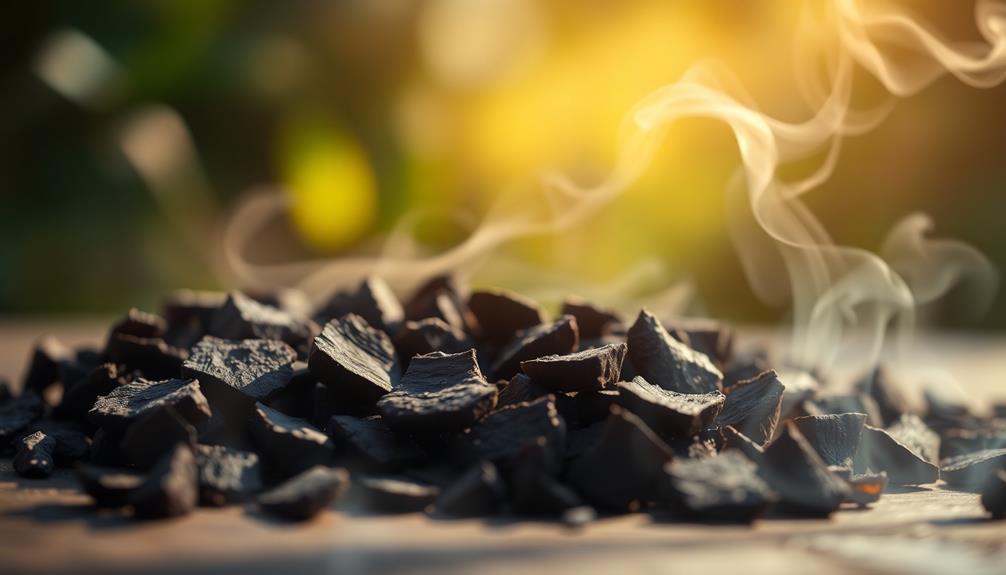
While the enchanting aroma of agarwood can elevate your senses, it's important to consider potential health and safety implications. Most people enjoy the scent, but some might experience allergic reactions or sensitivities to certain components in the oil or smoke. If you notice sneezing, headaches, or skin irritation, it's best to step back and take a break. Your comfort matters!
When using agarwood in incense or essential oils, make sure you're in a well-ventilated space. This helps prevent any buildup of smoke or strong scents that could trigger respiratory issues. If you have asthma or other breathing problems, it's wise to consult a doctor before using agarwood products.
Also, when purchasing agarwood, consider the source. Sometimes, lower-quality products can contain harmful additives or synthetic fragrances that aren't good for you. Always choose reputable sellers and look for natural options.
Final Thoughts

Considering the rich history and cultural significance of agarwood, it's clear why this aromatic gem has captivated many around the world. You might find it fascinating that agarwood isn't just a smell; it's a journey through time and tradition. When you take a moment to inhale its unique scent, you're experiencing a blend of woodiness, sweetness, and even a bit of spice. It's a complex aroma that invites you to explore deeper.
If you're thinking about using agarwood in your life, whether in incense, perfumes, or even in cooking, you'll discover it can add a special touch to any experience. Just remember, the smell can vary widely based on quality and source, so it's worth trying different types to find what resonates with you.
And while you're at it, don't hesitate to share your experiences with friends. Who knows? You might just spark their interest in this intriguing world of scents!
Frequently Asked Questions
Can Agarwood Be Used in Perfumes or Fragrances?
Yes, you can definitely use agarwood in perfumes or fragrances. Its rich, woody notes add depth and warmth, creating a luxurious scent profile that many find captivating and unique. It's a popular choice among perfumers!
How Does Agarwood Compare to Other Wood Scents?
When comparing agarwood to other wood scents, you'll notice agarwood's richness and depth stand out. It's more complex than cedar or sandalwood, offering earthy, sweet notes that create a uniquely captivating olfactory experience.
Are There Different Grades of Agarwood?
Yes, there are different grades of agarwood, and each grade varies in quality, fragrance, and price. You'll find premium grades are denser and richer in scent, while lower grades may be less aromatic or less desirable.
Is Agarwood Sustainable and Environmentally Friendly?
Agarwood can be sustainable if sourced responsibly from plantations or managed forests. However, overharvesting wild trees threatens its future. You should always verify the source to ensure you're supporting environmentally friendly practices.
What Are the Best Ways to Burn Agarwood?
To burn agarwood effectively, you'll want to use a charcoal burner or an incense holder. Ensure good ventilation, light the wood slowly, and enjoy the rich aroma as it fills your space.

